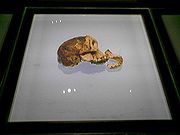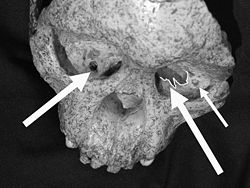
Taung, North West
Encyclopedia

Town
A town is a human settlement larger than a village but smaller than a city. The size a settlement must be in order to be called a "town" varies considerably in different parts of the world, so that, for example, many American "small towns" seem to British people to be no more than villages, while...
situated in the North West Province of South Africa
South Africa
The Republic of South Africa is a country in southern Africa. Located at the southern tip of Africa, it is divided into nine provinces, with of coastline on the Atlantic and Indian oceans...
. The name means place of the lion and was named after Tau, the chief of the Tswana
Tswana language
Tswana or Setswana is a language spoken in Southern Africa by about 4.5 million people. It is a Bantu language belonging to the Niger–Congo language family within the Sotho languages branch of Zone S , and is closely related to the Northern- and Southern Sotho languages, as well as the Kgalagadi...
speaking Legoya or BaTaung tribe. Tau is the Tswana word for lion
Lion
The lion is one of the four big cats in the genus Panthera, and a member of the family Felidae. With some males exceeding 250 kg in weight, it is the second-largest living cat after the tiger...
.
History of Research
In 1924 a skull (later named the Taung ChildTaung Child
The Taung Child — or Taung Baby — is the fossilized skull of a young Australopithecus africanus individual. It was discovered in 1924 by quarrymen working for the Northern Lime Company in Taung, South Africa...
) was discovered by a quarry
Quarry
A quarry is a type of open-pit mine from which rock or minerals are extracted. Quarries are generally used for extracting building materials, such as dimension stone, construction aggregate, riprap, sand, and gravel. They are often collocated with concrete and asphalt plants due to the requirement...
-worker in the nearby Buxton-limestone
Limestone
Limestone is a sedimentary rock composed largely of the minerals calcite and aragonite, which are different crystal forms of calcium carbonate . Many limestones are composed from skeletal fragments of marine organisms such as coral or foraminifera....
quarry. It was described by Raymond Dart
Raymond Dart
Raymond Arthur Dart was an Australian anatomist and anthropologist, best known for his involvement in the 1924 discovery of the first fossil ever found of Australopithecus africanus, an extinct hominid closely related to humans, at Taung in the North of South Africa in the province...
in 1925 as the type specimen of Australopithecus africanus
Australopithecus africanus
Australopithecus africanus was an early hominid, an australopithecine, who lived between 2–3 million years ago in the Pliocene. In common with the older Australopithecus afarensis, A. africanus was slenderly built, or gracile, and was thought to have been a direct ancestor of modern humans. Fossil...
after he received a shipment of mostly fossil baboon
Baboon
Baboons are African and Arabian Old World monkeys belonging to the genus Papio, part of the subfamily Cercopithecinae. There are five species, which are some of the largest non-hominoid members of the primate order; only the mandrill and the drill are larger...
s, but also containing the skull and face of the child. Surprisingly, it would be many years before Dart would visit Taung to determine the exact location of the find. By that time, lime-mining had destroyed much of the area. Later in-situ excavations were conducted under the direction of Phillip Tobias
Phillip V. Tobias
Phillip Vallentine Tobias is a South African palaeoanthropologist and Professor Emeritus at the University of the Witwatersrand in Johannesburg...
and Jeff McKee of the University of the Witwatersrand, who worked at the site from approximately 1989 until 1993. Although they failed to find additional hominid specimens, they did recover many important fossil baboons and increased the understanding of the Taung geology
Geology
Geology is the science comprising the study of solid Earth, the rocks of which it is composed, and the processes by which it evolves. Geology gives insight into the history of the Earth, as it provides the primary evidence for plate tectonics, the evolutionary history of life, and past climates...
and taphonomy
Taphonomy
Taphonomy is the study of decaying organisms over time and how they become fossilized . The term taphonomy was introduced to paleontology in 1940 by Russian scientist Ivan Efremov to describe the study of the transition of remains, parts, or products of organisms, from the biosphere, to the...
significantly.
Taphonomy

Charles Kimberlin Brain
Charles Kimberlin Brain , born in Southern Rhodesia in 1931, is an eminent South African paleontologist who has studied and taught African cave taphonomy for more than fifty years.-Biography:From 1965 to 1991, Dr...
demonstrated that the child was probably killed by some sort of mammalian carnivore
Carnivore
A carnivore meaning 'meat eater' is an organism that derives its energy and nutrient requirements from a diet consisting mainly or exclusively of animal tissue, whether through predation or scavenging...
such as a leopard
Leopard
The leopard , Panthera pardus, is a member of the Felidae family and the smallest of the four "big cats" in the genus Panthera, the other three being the tiger, lion, and jaguar. The leopard was once distributed across eastern and southern Asia and Africa, from Siberia to South Africa, but its...
. Recently, however, studies of the associated baboons by Ron Clarke
Ronald J. Clarke
Ronald J. Clarke is a paleoanthropologist most notable for the discovery of "Little Foot", an extraordinary complete skeleton of Australopithecus, in the Sterkfontein Caves...
and Lee Berger
Lee R. Berger
Lee Rogers Berger is a paleoanthropologist, physical anthropologist and archeologist and is best known for his discovery of Australopithecus sediba and his work on Australopithecus africanus body proportions and the Taung Bird of Prey Hypothesis.-Background:Berger was born in Shawnee Mission,...
, and identification of specific marks on the Taung Child skull have demonstrated that the Taung Child may have been killed and eaten by a large bird of prey
Bird of prey
Birds of prey are birds that hunt for food primarily on the wing, using their keen senses, especially vision. They are defined as birds that primarily hunt vertebrates, including other birds. Their talons and beaks tend to be relatively large, powerful and adapted for tearing and/or piercing flesh....
.
Geology
Unlike the dolomitic caves near JohannesburgJohannesburg
Johannesburg also known as Jozi, Jo'burg or Egoli, is the largest city in South Africa, by population. Johannesburg is the provincial capital of Gauteng, the wealthiest province in South Africa, having the largest economy of any metropolitan region in Sub-Saharan Africa...
, South Africa and the site of Makapansgat
Makapansgat
Makapansgat is an archeological location within the Makapansgat and Zwartkrans Valleys, northeast of Mokopane in Limpopo province, South Africa. It is an important paleontological site, with the local limeworks containing Australopithecus-bearing deposits dating to between 3.0 and 2.6 million years...
, the Taung fossil sites are found in caves formed in a gigantic tufa flow coming off the dolomitic bedrock of the Kalahari escarpment.
About the Taung Child
The Taung Child is among the most important early human fossils ever discovered. It was the first hominid to be discovered in Africa, a species later named Australopithecus africanusAustralopithecus africanus
Australopithecus africanus was an early hominid, an australopithecine, who lived between 2–3 million years ago in the Pliocene. In common with the older Australopithecus afarensis, A. africanus was slenderly built, or gracile, and was thought to have been a direct ancestor of modern humans. Fossil...
, supporting Charles Darwin
Charles Darwin
Charles Robert Darwin FRS was an English naturalist. He established that all species of life have descended over time from common ancestry, and proposed the scientific theory that this branching pattern of evolution resulted from a process that he called natural selection.He published his theory...
's concepts that the closest living relatives of humans are the African apes. It furthermore demonstrated significant differences between reality and the fake skull of a proposed human ancestor from England
England
England is a country that is part of the United Kingdom. It shares land borders with Scotland to the north and Wales to the west; the Irish Sea is to the north west, the Celtic Sea to the south west, with the North Sea to the east and the English Channel to the south separating it from continental...
known as the Piltdown Man
Piltdown Man
The Piltdown Man was a hoax in which bone fragments were presented as the fossilised remains of a previously unknown early human. These fragments consisted of parts of a skull and jawbone, said to have been collected in 1912 from a gravel pit at Piltdown, East Sussex, England...
or Eoanthropus. The little skull is hypothesized to be from an approximately three to three and a half year old child. The cast of the brain
Brain
The brain is the center of the nervous system in all vertebrate and most invertebrate animals—only a few primitive invertebrates such as sponges, jellyfish, sea squirts and starfishes do not have one. It is located in the head, usually close to primary sensory apparatus such as vision, hearing,...
is preserved by the filling of the skull with limestone breccia
Breccia
Breccia is a rock composed of broken fragments of minerals or rock cemented together by a fine-grained matrix, that can be either similar to or different from the composition of the fragments....
. The skull is housed at the University of the Witwatersrand
University of the Witwatersrand
The University of the Witwatersrand, Johannesburg is a South African university situated in the northern areas of central Johannesburg. It is more commonly known as Wits University...
in Johannesburg
Johannesburg
Johannesburg also known as Jozi, Jo'burg or Egoli, is the largest city in South Africa, by population. Johannesburg is the provincial capital of Gauteng, the wealthiest province in South Africa, having the largest economy of any metropolitan region in Sub-Saharan Africa...
, South Africa.
See also
- Hominids
- Cradle of HumankindCradle of HumankindThe Cradle of Humankind is a World Heritage Site first named by UNESCO in 1999, about 50 kilometres northwest of Johannesburg, South Africa in the Gauteng province. This site currently occupies ; it contains a complex of limestone caves, including the Sterkfontein Caves, where the 2.3-million...
- List of fossil sites

